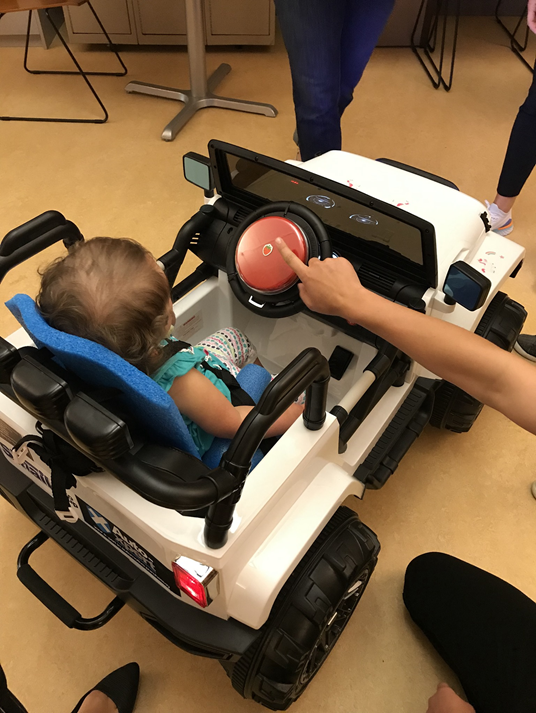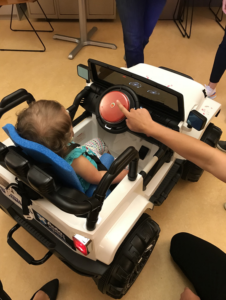 GoBabyGo Provides Children with Disabilities the Gift of Mobility
GoBabyGo Provides Children with Disabilities the Gift of Mobility
By Courtney Gerhart, DPT
Pediatric Physical Therapy, Kids Place West
During the first few years of a child’s life, they begin to explore their environment and make crucial connections that will inevitably set them up for success mentally, physically, socially and emotionally. A typically developing child will begin to crawl around 6-12 months of age and eventually begin walking at 9-15 months of age. However, this is not the case for every child, especially those dealing with a chronic or lifelong diagnosis affecting their mobility skills such as cerebral palsy, spina bifida or muscular dystrophy. These children will become reliant on their parents and other family members to carry them from point A to point B, thereby eradicating the child’s independence and self-controlled mobility. They will be unable to explore their surroundings and make social connections with others which is crucial to their cognitive and motor development.
This is where the national, community-based research, design and outreach program GoBabyGo comes into play. This non-profit organization originally created by Cole Galloway at the University of Delaware in 2012, provides modified, ride-on toy cars to children birth to age 3 who experience limited mobility. This program is unique in its ability to integrate assistive technology, clinicians, families and industry partners to provide children with disabilities movement and mobility opportunities as well as socialization with their peers and loved ones.
How is this Possible?
Since GoBabyGo is a non-profit and national outreach program, each chapter is responsible for fundraising all necessary costs in order to pay for and modify the ride-on toy cars. This means the family pays $0 for the modified car, which allows them more time to focus on quality bonding with their child and less time worrying about troublesome financial factors. The families/children who apply for a car with their local chapter specify the diagnosis of the child, special requests or modifications that need to be made based on the diagnosis, as well as general/fun information such as the child’s preferred car color and other interests that can be incorporated with the decorating process. Once this intake form/process is complete, the building begins!
Building the GoBabyGo Cars
The cars may differ based on the chapter of GBG involved, however many chapters appear to purchase their cars through Amazon. Once the cars are purchased and shipped to the program, the modifying begins! The cars typically come with a building manual and are pretty straight forward to construct. However, once it comes to the wiring process, things become a tad bit different than one might expect. The wire that connects down to the gas petal is actually stripped and re-wired up through the steering wheel where it is attached to a large push button. This allows children with limited to no use of their legs to use their hand(s) to push the button on the steering wheel to go! Once the rewiring has been successfully completed, the car is finished with the total cost ranging from $200-$350 per car which includes the car itself, the push button, decorations to place on the car and other accessories such as pool noodles and harnesses necessary for patient modifications.
Benefits of Early Mobility
GoBabyGo provides independence and mobility to children who desire to explore their surroundings, just like their age-matched peers. Past research has shown that independent mobility is linked to cognitive, social, motor, language and other developmental benefits in young children. Being pushed in a stroller or carried from one place to another is much different from having active control over one’s exploration which is where the developmental gains are made. The child’s independent mobility allows them to understand their environment layout such as the height of objects around them and navigating with safety awareness by avoiding obstacles. It also allows for more parental and peer interactions as well as engagement in quality play. This social exploration aids in the development of facial expressions, gestures, etc. and improves emotional, social, motor and speech components necessary for successful development.
How to get involved in GoBabyGo
You can gain access to contact information for people who are interested in helping to build cars for children in their communities and/or starting their own local GoBabyGo programs by visiting their website. If you need a car or you want to help a community GBG effort in other ways, reach out to your local contact person. If you’re interested in starting a program in your community, please contact udgobabygo@udel.edu, and they will add your contact information to the list.
Kids Place Pediatric Therapy serves children with disabilities all throughout Arizona. Visit our website today to learn more.
References:
- At GoBabyGo! we are committed to a single, urgent vision: All people exploring their world via independent mobility! (n.d.). Retrieved November 29, 2020, from https://sites.udel.edu/gobabygo/.
- Butler, C. (1986). Effects of powered mobility on self‐initiated behaviors of very young children with locomotor disability. Developmental Medicine & Child Neurology, 28(3), 325-332.
- Go Baby Go. (n.d.). Retrieved November 29, 2020, from https://www.yourcpf.org/cpproduct/go-baby-go-the-ultimate-toy-hack/.
- Huang, H. H. (2018). Perspectives on early power mobility training, motivation, and social participation in young children with motor disabilities. Frontiers in psychology, 8, 2330.








